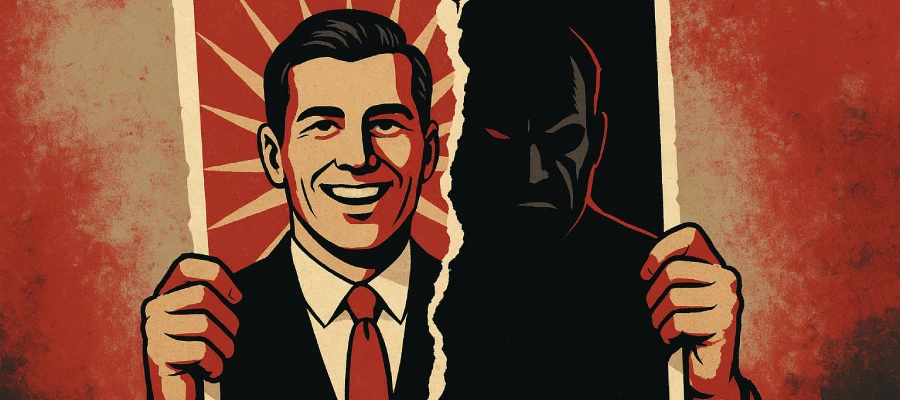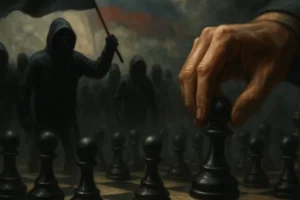The Danger of Preemptive Accusation
Projection is a term rooted in psychology that describes the act of attributing one’s own undesirable traits, motives, or actions to others. While it often occurs subconsciously in personal relationships, projection can also be wielded strategically, particularly in politics and propaganda, as a way to deflect attention and control narratives. When those in power use this tactic to avoid accountability, it becomes a method of manipulation that can lead to public confusion and, ultimately, a breakdown in trust and accountability.
Today, I want to discuss the role of “strategic projection” and “preemptive accusation” in modern discourse, examine how these tactics can be hard to recognize, and provide a few tools to help identify and counteract them. Why? Because it can be really easy to fall for this nonsense if you are unaware. Some of this might get a little technical, but stick with me. I should make sense by the end.
The Mechanics of Strategic Projection and Preemptive Accusation
Strategic Projection is a deliberate form of projection where an individual accuses others of actions or motives that they themselves are guilty of, especially to shift blame or confuse the public. When used by those in positions of power, it serves as a powerful mechanism of deflection and misdirection, making it difficult for critics to hold them accountable. By turning the accusation around, the projector creates a false equivalence between themselves and their opponent, effectively neutralizing potential attacks and casting doubt on the validity of any claims against them.
A related tactic, preemptive accusation, involves accusing an opponent of wrongdoing before there’s even a chance for them to respond or for an accusation to be levied against the accuser. This approach establishes a narrative before any actual investigation occurs, shaping public perception and forcing the opponent onto the defensive. Together, these tactics create a smokescreen around the accuser’s actions, leaving the public uncertain about who is truly at fault and what the facts actually are.
How and Why Strategic Projection is Difficult to Recognize
The effectiveness of projection lies largely in how it taps into common cognitive biases and societal conditioning. One of the key reasons it often goes unrecognized is the phenomenon of Epistemic Rigidity, where individuals or groups become resistant to changing their beliefs even in the face of contradictory evidence. People conditioned to trust a certain leader or political party may struggle to consider that these trusted figures could engage in wrongdoing, particularly if accusations against their opponents align with preconceived biases.
Indoctrination also plays a significant role. Political groups or leaders often cultivate loyalty through ideological alignment, framing themselves as defenders of a specific value system. Once followers are invested, they may adopt a mindset where they are unable to view criticism as valid, believing that any accusation must be a strategic move by an opponent. This conditioning (and it is conditioning) can prevent individuals from recognizing manipulation, even when evidence begins to surface. Unfortunately, this is a massive problem, and I have found that those who are actively victims often do not know (and often don’t want to know) that they are.
In political discourse, projection is difficult to identify because of the strategic use of misinformation and propaganda. Propaganda harnesses the power of repetition and emotional appeal to reinforce a preferred narrative, drowning out opposing viewpoints. When projection is employed in this manner, people are constantly exposed to the idea that “the other side” is corrupt, deceitful, or dangerous, while the accuser positions themselves as a moral authority. If something they say “sounds about right,” the contorted message resonates and the effort is repeated until it becomes their truth or their new norm. This continuous reinforcement can make it difficult for the public to distinguish between genuine concern and manipulative rhetoric.
The Role of Projection in Propaganda
Projection has been a staple in propaganda tactics throughout history. This isn’t new. Leaders and regimes have used it to suppress dissent, justify authoritarian measures, and control public perception. When used in propaganda, projection often presents in a simplified, emotionally charged manner, making it difficult for individuals to step back and critically assess the message. It paints complex issues as black-and-white, leveraging confirmation bias to reinforce what people already believe and casting opponents as the enemy.
An easy example here might be the Patriot Act. People who identified as “Patriots” lined up to support a bill that ultimately curtailed their own civil liberties, all under the guise of national security. The naming alone was a strategic move. Those in power deliberately positioned those who opposed them as unpatriotic. This is the core power of projection in propaganda. It flips reality, assigning the regime’s own faults or intentions to its adversaries, thereby shielding itself from scrutiny.
What I want you to understand is that the more emotionally resonant the framing, the more resistant the public becomes to contradictory evidence. This not only distorts the truth but also inoculates the population against rational discourse, cementing the very biases that make critical thought unwelcome or even dangerous. In other words, when fear or pride shapes the message, facts become irrelevant, and people will defend the lie as if it’s part of their identity.
Accusation in a mirror is a well-known propaganda technique that relies heavily on projection. By accusing an opponent of actions or intentions that the accuser is guilty of, this technique not only deflects criticism but also amplifies distrust and enmity toward the targeted group. This approach is particularly dangerous in times of political or social tension, as it can provoke division and even incite violence by presenting the opponent as an imminent threat. If you want or need evidence of this, just look at recent news feeds.
Why Some Refuse to See It
Many individuals remain unaware of projection in politics and propaganda due to several psychological and social factors. Indoctrination and ideological loyalty can cause people to view their preferred leaders or organizations as infallible, leading them to dismiss criticisms as mere political attacks. Motivated reasoning, which is the tendency to interpret information in a way that aligns with preexisting beliefs, also plays a big role. For some, acknowledging that a trusted leader could engage in deceit or wrongdoing would challenge their entire belief system, so they rationalize or ignore evidence to maintain their worldview.
Social identity is another major factor that influences people’s ability to recognize projection. When political beliefs become part of an individual’s identity, they often unconsciously prioritize loyalty over critical thinking. In such cases, admitting that one’s “side” is at fault can feel like a betrayal, leading to a strong tendency to reject opposing perspectives regardless of their validity.
Consequences of Failing to Recognize Projection
When projection goes unrecognized, it enables deceptive individuals or groups to continue their misconduct with minimal resistance. It can erode public trust, fostering a culture where truth is difficult to discern and accountability is rare. In extreme cases, unchecked projection can lead to social instability, as populations become divided and less willing to cooperate across political or ideological lines. Furthermore, projection allows for the solidification of power; by casting opponents as perpetual wrongdoers, those in power can justify repressive measures, limiting freedoms, and suppressing dissent.
Identifying Projection and Strategic Projection in Political Contexts
Projection, particularly as a strategic tool in politics, can be challenging to identify because it often mirrors the accuser’s own behavior onto their opponent, creating confusion and deflecting scrutiny. However, I may have a way. Detecting projection requires careful observation, critical inquiry, and structured questioning to reveal whether an accusation is grounded in reality or serves as a tactic to mislead. Of course, this requires a strategy. Here are several approaches to identifying projection or strategic projection:
1. Contrastive Inquiry Method (CIM)
Yes, I talk about this a lot. However, I do so because it is an extremely powerful tool. In this instance, the Contrastive Inquiry Method (CIM) helps us to detect inconsistencies and contradictions in accusations. CIM involves directly contrasting a claim with its logical opposite and then framing this contrast as a question to test the claim’s validity. This method encourages deeper investigation into the truth of an accusation by considering alternative possibilities and verifying evidence.
- Example: Suppose a politician claims, “I’m the only one telling the truth.”
- Contrast: “The politician might not be the only one telling the truth.”
- Inquiry: “Are there others presenting valid information or perspectives?”
- Follow-Up Questions: Are there credible sources that contradict this politician’s statements? Has this politician been proven to distort facts in the past?
By methodically questioning the contrast, CIM helps expose inconsistencies in accusations, which often reveal projection. If a political figure frequently claims they are the sole truth-teller while accusing opponents of deceit, CIM can help determine if this is an attempt to project their own lack of transparency onto others. More importantly, it can help expose whether someone is hiding something.
2. Pattern Analysis: Frequent, Unsupported Accusations
Of course, it helps to pay attention. Projection often emerges as a pattern of accusations that are repeated but lack substantial evidence. However, by analyzing accusations over time, one can identify whether a political figure habitually accuses others of the same wrongdoings they themselves are implicated in. For example, if a politician consistently accuses opponents of corruption while evading scrutiny over their own finances, it’s worth investigating the pattern.
- Inquiry: Has the accuser faced similar accusations or allegations in the past? Are these accusations conveniently timed to distract from their own issues?
This pattern-based approach is particularly helpful on social media, where repeated accusations can sway public opinion quickly without the need for solid evidence.
3. Check for Sudden, Reactive Accusations
Projection is often a deflective response to sudden scrutiny. When a political figure faces criticism or allegations, they may project by making a similar accusation against their opponent to shift focus. Observing the timing and context of accusations can reveal if they are reactive rather than proactive.
- Contrastive Inquiry Example: Suppose a politician accused of financial misconduct suddenly accuses their opponent of fraud.
- Contrast: “Is the opponent actually guilty of fraud, or is this accusation a reactive deflection?”
- Inquiry: “Is there verifiable evidence of fraud by the opponent, or is this accusation simply shifting focus?”
Understand that if an accusation appears only when the accuser is under scrutiny, it’s likely a projection intended to deflect attention.
4. Assess Emotional Appeals and Language
Projection relies on emotionally charged and polarizing language, as it encourages quick, emotional responses that bypass critical thinking. Accusations that rely on fear, anger, or distrust, rather than facts, are often projections. Strategic projection is particularly effective when it plays on deep-rooted biases or societal divisions, making people react strongly without verifying information.
- Inquiry Example: “Is the accusation rooted in objective evidence, or does it primarily appeal to emotions?”
Emotionally loaded accusations are often designed to divert attention from the accuser’s own actions by manipulating public sentiment. I’ll give you a few examples to consider:
- “They’re trying to take away your freedom!” – Often used by those enacting restrictive measures themselves, projecting authoritarian intent onto opponents.
- “They hate our values and want to see us fail!” – A polarizing accusation that turns ideological disagreement into a personal or existential threat.
- “Only we are telling the truth—they’re spreading misinformation.” – A binary frame that weaponizes distrust to shield one’s narrative from scrutiny.
- “They’re the real fascists!” – A reversal tactic often used to mask authoritarian behavior by preemptively labeling dissent or resistance as oppressive.
5. Identify “Mirror Tactics” in Propaganda
In political propaganda, projection frequently uses “mirror tactics,” where accusations are flipped to cast opponents as guilty of the very actions the accuser is involved in. This tactic leverages the simplicity of “us versus them” (A/B Fallacy) narratives, making it seem as though the opponent embodies all the negative traits of the accuser. Examining these simplified narratives and language can reveal whether a message is attempting to project a false image onto others.
- Contrastive Inquiry Example: Suppose a campaign accuses an opponent of threatening national security.
- Contrast: “Is there substantial evidence that the opponent threatens national security, or is this narrative a mirror of the accuser’s own actions?”
- Inquiry: “What objective measures support this accusation? Is there documentation, or is it merely a rhetorical claim?”
By questioning the validity of these mirror images, one can discern whether the projection is part of a larger narrative meant to manipulate public opinion.
6. Use Logical Consistency Tests
Projection often leads to contradictions when accusations don’t align with the accuser’s other statements or actions. Logical consistency tests involve examining whether an accusation logically fits with the accuser’s behavior. For example, if a leader who promotes honesty in politics suddenly accuses an opponent of dishonesty without presenting evidence, this inconsistency raises questions about their motives.
- Contrastive Inquiry Example: “The accuser values honesty.”
- Contrast: “Does the accuser value honesty, or is this a front?”
- Inquiry: “Does the accuser consistently demonstrate honesty in their own actions? If not, is this accusation projection?”
Logical consistency tests expose contradictions in projected accusations, highlighting where projection serves as a tactical shield.
7. Track Public Misinformation and Manipulative Narratives
Projection is often amplified through misinformation, where unfounded accusations are repeated widely to solidify a narrative. On social media, political accusations can spread quickly, shaping public perception through repetition rather than accuracy. Observing the dissemination of these accusations can help reveal projection, especially when misinformation is spread to benefit the accuser.
- Inquiry Example: “Are there coordinated efforts to spread the accusation widely, even without evidence? Who benefits from this narrative?”
If an accusation gains traction through repeated but unsupported statements, it’s likely a projection tactic using misinformation to manipulate perceptions.
8. Analyze the Broader Social Context for Preexisting Biases
Projection is more effective when it aligns with preexisting public biases. Political figures often tailor accusations to exploit common fears or prejudices, amplifying their impact. Examining the social context in which accusations arise helps determine whether they are grounded in genuine concern or if they are attempts to weaponize bias for projection.
- Contrastive Inquiry Example: Suppose a politician claims their opponent is “unpatriotic.”
- Contrast: “Is the opponent genuinely unpatriotic, or is this an attempt to weaponize bias?”
- Inquiry: “What specific actions suggest a lack of patriotism, and is this accusation consistent with the opponent’s past behavior?”
Understanding how accusations align with social biases helps differentiate between genuine concern and manipulative projection.
Real-World Case Study: Watergate and the “Law and Order” Narrative
A classic example of strategic projection can be seen in the Watergate scandal of the 1970s. President Richard Nixon’s administration projected a strong “law and order” narrative, presenting Nixon as a defender of justice and morality. This stance was widely broadcast to the American public, with Nixon’s administration painting opponents and dissenters as threats to national stability. Meanwhile, Nixon and his staff were engaged in illegal activities, including burglary, wiretapping, and attempts to cover up these crimes.
By the time the scandal was fully exposed, the American public felt a deep sense of betrayal, as the very figure promoting “law and order” had been violating the law to maintain his political power. The effects were profound: widespread public distrust, the resignation of the president, and the conviction of several administration officials. The Watergate scandal not only highlighted the consequences of unchecked projection but also illustrated how damaging it can be when a leader’s actions go unexamined for too long.
Final Thoughts
Projection and preemptive accusation are powerful tactics that, when used strategically, can obscure truth, erode trust, and divide societies. Recognizing these tactics requires critical thinking and a willingness to question even those we trust. By employing tools like the Contrastive Inquiry Method and maintaining awareness of cognitive biases, individuals can better identify when they are being manipulated. Understanding these dynamics is crucial to protecting democratic processes, ensuring accountability, and fostering a more informed and resilient society.
Ask questions. Contrast claims. Don’t outsource your judgment to someone who doesn’t care about you.




